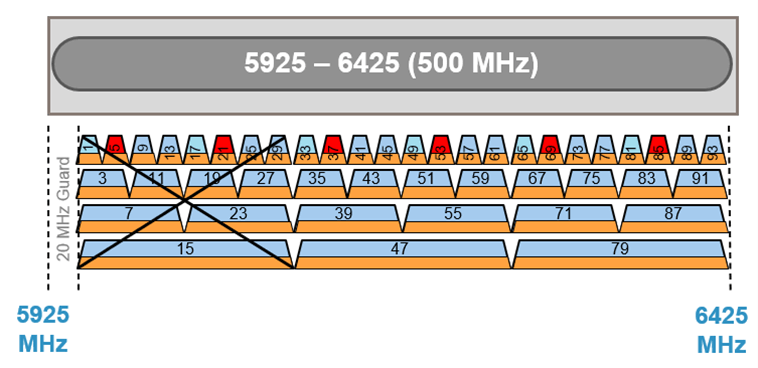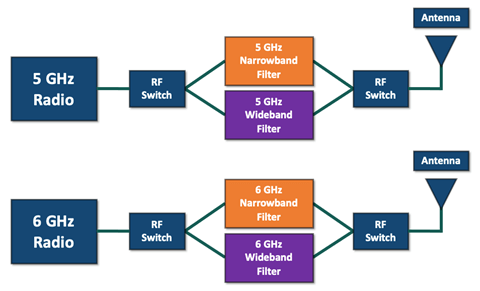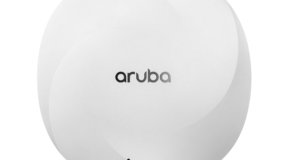
Wi-Fi 6E represents the most significant expansion of spectrum for unlicensed use to date – adding the 6 GHz band and remarkably increasing Wi-Fi capacity. However, a challenge with Wi-Fi 6E is that the 6 GHz and 5 GHz bands are immediately adjacent (only 50 MHz apart). Traditional filtering technology can't adequately separate the two bands, as the design requires a larger gap between the bands, and using that older technology would require some tradeoff in flexibility when deploying 6 GHz.
Wi-Fi 6E challenge: 5 GHz to 6 GHz filtering
Traditional bandpass filters fall short because they are too coarse and can block up to 1/3 of the 6 GHz channels in EMEA and 10% of the 6 GHz channels in North America. It’s clear that radio frequency filtering technology must become more fine-grained and dynamic to mitigate the interference issues effectively and maximize utilization of the channels.
This post reviews what bandpass filters are and do. I will cover two existing examples found in Aruba access points. Last, I will cover Aruba’s innovative new bandpass filtering technology: ultra tri-band (UTB). Separately, you can also explore our newest Wi-Fi 6E AP, the 650 Series Campus Access Points, that we announced today.
What are bandpass filters?
Bandpass filters are purpose-built devices placed in line between the antenna and radio. Their purpose is to allow specific frequencies while rejecting other unwanted signals.
To visualize, humor me and think about an opening between two solid walls. Imagine a single wave of water heading in the direction towards those walls. Most of the water will not cross through at impact except where there is an opening. This is what bandpass filters do. If the signal is too high or too low in frequency, the signal will not pass.
Bandpass filters have another key role. When a radio sends a transmission, the noise floor rises. A radio inside the same access point, on another band, must filter that received signal. If it does not, performance may be negatively affected.
Some history: Existing Aruba filtering techniques
There are two existing examples of filtering techniques, used in Aruba access points, that prevent adjacent-band and in-band interference. These are not for 6 GHz, but for the 2.4 GHz radios.
Advanced IoT Coexistence (AIC) allows both Wi-Fi and IoT radios to concurrently operate in the 2.4 GHz band. AIC uses filtering to prevent overlapping interference from Wi-Fi entering the IoT radio. The Internet of Things (IoT) radio provides integrated operation and functionality for BLE or Zigbee.
Advanced Cellular Coexistence (ACC) filters out signals from above and below the 2.4 GHz Wi-Fi band. This prevents small cell interference with Access Points when installed nearby. So, ACC protects Wi-Fi from interference caused by cellular distributed antenna systems.
Traditional filtering tradeoffs with 6 GHz
Co-located 6 GHz and 5 GHz radios in the same access point pushes the application of traditional bandpass filters beyond their ability to reject unwanted noise. The frequency gap between bands, measured from U-NII-4 (served by the 5 GHz radio) to U-NII-5 (served by the 6 GHz radio), is too small at about 50 MHz wide.

Only 50 MHz of separation between 5 GHz and 6 GHz leads to interference
The problem is traditional bandpass filters need a gap of about 200 MHz between channels. Without a sufficient gap, the filter cannot block unwanted energy from channels in other bands. Also, these traditional bandpass filters are not steep enough. If they are used on both bands then channel restrictions are required, somewhere.

Traditional filters fall off too gradually and restrict channel usage in both 5 GHz and 6 GHz
Restricting channels on both bands does not make sense. Why sacrifice channels in both bands? One option with traditional bandpass filters is to shift the filter high, restricting use of lower 6 GHz channels. Some implementations, found in other 6E capable access points from different manufacturers, are shifted high, fixed, and not configurable.

One option with traditional filters is to restrict 6 GHz channels and provide full use of the 5 GHz band but this significantly limits the capacity of the 6 GHz band.
Giving up the flexibility to use these lower 6 GHz channels, on a given access point, is less than ideal. Especially considering regulatory domains where the full 1200 MHz of the 6 GHz band is not allowed. For example, in regions where only the lower 500 MHz is allowed (i.e., European Union), giving up the bottom eight 20 MHz channels means not using a third of the 6 GHz band.
 Using traditional filters and only restricting the 6 GHz band translates into cutting off one-third of the channels in the European model.
Using traditional filters and only restricting the 6 GHz band translates into cutting off one-third of the channels in the European model.
Aruba’s innovative approach: Ultra tri-band filtering
Aruba addresses these adjacent multi-band filtering challenges with a patent pending filtering technology: ultra tri-band filtering (UTB).
How does it work? Ultra tri-band filtering combines hardware and software to dynamically apply bandpass filters across 5 GHz and 6 GHz. This allows channel selection for any available channels on the same access point.

Block diagram showing the high-level architecture for UTB
This means Aruba’s Wi-Fi 6E APs with ultra tri-band filtering can operate, maximize performance (range and throughput), and provide simultaneous service – without interference – on closely adjacent channels between bands including the lowest available 6 GHz channel and highest available 5 GHz channel.
Ultra tri-band filtering allows you to take advantage of all the new channels available in the 6 GHz band to support growing demands due to more devices, more cloud, services and accelerated digital transformation initiatives.
Explore Wi-Fi 6E and ultra tri-band filtering
Footnotes
- U-NII-4 will be enabled via software upgrade on compatible hardware in an upcoming software release. Stay tuned for more later this year.




